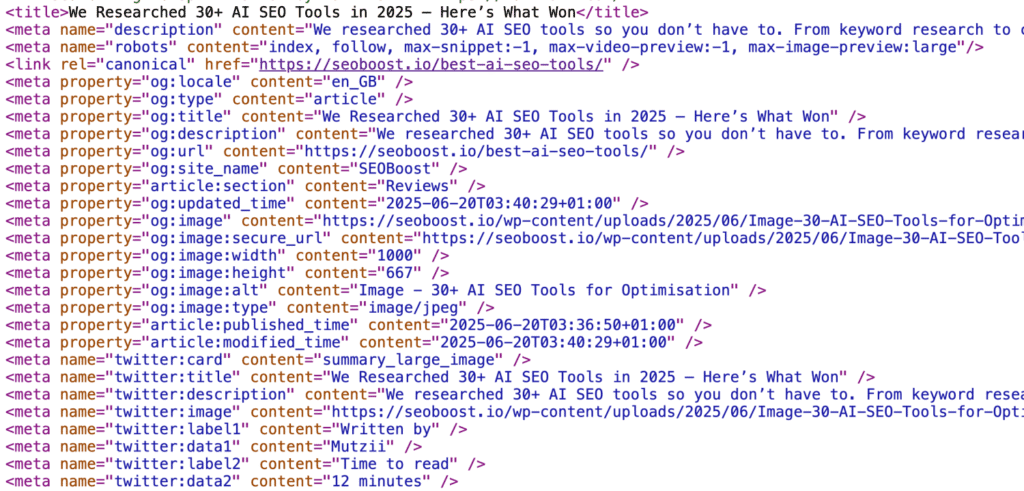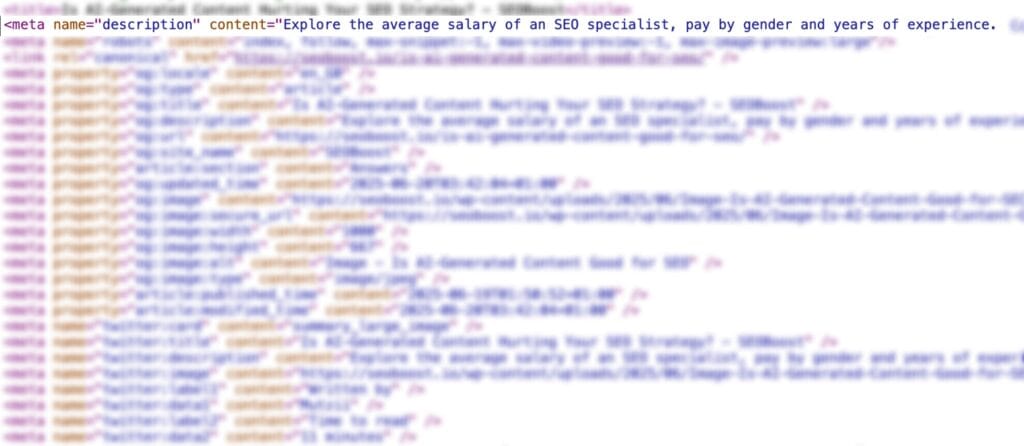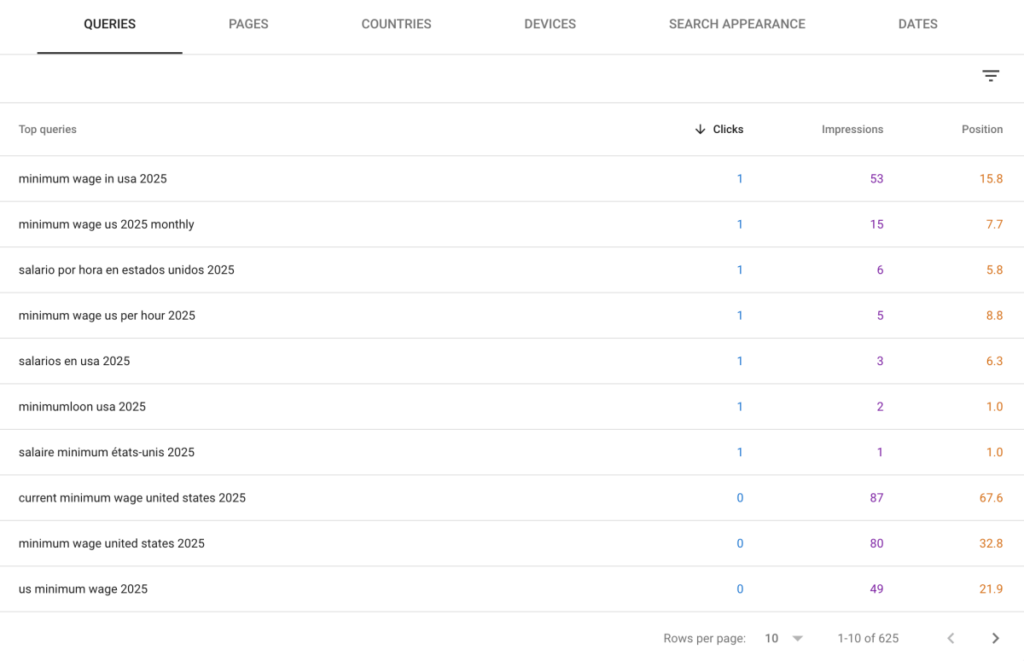Let’s be real—between AI writing tools generating content faster than you can say “meta description tag” and Google casually rewriting your snippets, you might be tempted to ask: Are meta tags still a thing?
Some say the meta keywords tag is ancient history. Others claim that HTML tags are just digital decoration. And yes, search engines have definitely gotten smarter. But here’s the twist: meta tags still hold serious power when it comes to SEO, especially when used right.
In fact, I have proof. Just recently, I discovered something eye-opening when I accidentally overlooked the meta tags on an article we’d just published. Spoiler: it got interesting.
But I won’t give it all away up here. Scroll on, because this article breaks down which meta tags for SEO still matter, how HTML elements impact your ranking, and what your web page really needs to show up in search results.
What Are Meta Tags in HTML?
Meta Tag Basics
Let’s start at square one—what is a meta tag?
A meta tag in HTML is a small but mighty piece of code that lives in thesection of your web page. These meta tags are HTML elements that don’t show up on the front end of your site but speak directly to search engines like Google.

Think of them as the secret whispers between your site and search engines, helping bots understand your content, from your meta description to your meta keywords. While tags are HTML by nature, they carry significant SEO weight when used right.
Meta tags for SEO include things like the title tag, meta description tag, and even meta keywords (though Google doesn’t really use that one anymore—more on that later). Still, each meta tag plays a specific role in improving your site’s visibility in search results.
These tags are important because they help define how your web page is indexed, understood, and even displayed on a search engine result page (SERP). Bottom line: if you’re skipping meta tags, you’re leaving SEO points on the table.
Common HTML Attributes Used in Meta Tags
Meta tags might seem simple, but under the hood, they’re made up of different HTML attributes that communicate with search engines.
One of the most common is the name attribute, which tells the browser or bot what kind of information it’s reading—like description, keywords, or robots. Then there’s the content attribute, which holds the actual info, such as your list of keywords or your well-crafted meta description.
Other important meta attributes include charset (which defines character encoding for the HTML document) and http-equiv (used in tags like the meta refresh tag or the viewport meta tag).
These HTML tags may not be flashy, but they’re foundational to building a strong SEO strategy. They’re how you tell search engines, “Hey, here’s what this page is all about.”
| Attribute | Purpose | Example |
|---|---|---|
name |
Defines the type of meta tag | <meta name="description" content="..." /> |
content |
Holds the actual value or data | <meta name="keywords" content="SEO, html, meta tag" /> |
charset |
Sets character encoding for the HTML document | <meta charset="UTF-8"> |
http-equiv |
Acts like an HTTP header (e.g., refresh, content-type) | <meta http-equiv="refresh" content="5; url=/new-page.html" /> |
property |
Used mainly for Open Graph (social media preview) | <meta property="og:title" content="..." /> |
name="viewport" |
Controls layout on mobile devices | <meta name="viewport" content="width=device-width, initial-scale=1.0"> |
Why Meta Tags Are Important for SEO
Now let’s get to the juicy part—why meta tags still matter for SEO in 2025.
Meta tags help search engines understand the content and purpose of your web page. They influence how your site appears in a search result and help shape the overall user experience. That’s a big deal for both ranking and click-through rate.
Take the meta description, for instance. While Google may sometimes rewrite it, a well-written meta description tag can still compel a user to click on your page over someone else’s. That’s not just user experience—it’s straight-up SEO performance.
Meta tags like the robots meta tag, canonical tag, and open graph meta tags also play key roles in directing bots, managing duplicate content, and controlling how your content looks when shared on social media.
At the end of the day, meta tags are HTML elements that work behind the scenes—but their impact on your SEO efforts is very real. They might not guarantee a #1 ranking, but they sure help get you closer.
Essential HTML Meta Tags for SEO
You’ve heard the hype—and the skepticism. But when it comes to on-page SEO, a few key meta tags still do some heavy lifting behind the scenes. Here’s a breakdown of the ones you actually need to care about.
The Meta Description Tag
Ah, the meta description—the elevator pitch of your web page.
A meta description is a short summary of your page’s content that appears in search results. It doesn’t directly impact your SEO ranking, but it does affect how likely someone is to click on your link. That’s right: this little meta tag can make or break your click-through rate.
While Google doesn’t always use the meta description tag you provide (sometimes it just does its own thing), writing a well-crafted one still matters. Why? Because when Google does show it, that’s your shot to hook a user.
Tips for a compelling meta description:
Use relevant keywords naturally—avoid keyword stuffing
- Summarise your content clearly
- Keep it under 160 characters
- Make it irresistible. You’re not writing a label, you’re writing a teaser
Pro tip: use the description meta tag to align your messaging with your actual page content. It’s a small move that signals quality to search engines and trust to users.
Meta Keywords Tag
Now let’s address the fossil in the room: the meta keywords tag.
Once upon a time, you could load your meta tag in HTML with a juicy list of keywords and watch your SEO ranking rise. But then everyone abused it. Keyword stuffing happened. Chaos ensued. And Google, in all its algorithmic wisdom, decided, “Nope.”
Today, the meta keywords tag has been pretty much ignored by all major search engines. So why even mention it?
Because it’s still floating around legacy HTML code, and some niche engines or internal search tools may still consider it. So if you’re feeling nostalgic, or optimizing for something other than Google, you can still include relevant keywords—just don’t expect miracles.
In most cases, it’s safe to skip this one for modern SEO efforts.
The Title Tag vs Meta Title
Okay, this one causes confusion—so let’s clear it up.
The title tag is the actual HTML element that defines the title of your web page. It appears in browser tabs, and, more importantly, in Google search results as the clickable headline.
The term meta title is often used interchangeably, but technically it’s not a real meta tag. It’s just a naming habit marketers picked up somewhere between keyword audits and coffee breaks.

So how does the title tag affect SEO?
A lot. It’s one of the most important meta tags for SEO. It helps search engines understand your page’s content and plays a major role in determining your ranking.
Best practices for your title tag:
Include your primary keyword
- Keep it under 60 characters
- Make it engaging—think like a human, not a robot
- Avoid duplicate meta descriptions and titles
While Google may sometimes rewrite your title (classic), giving it a solid structure using meta tags like the title tag still gives your content a fighting chance in a crowded search result.
Post/Page Title vs. Meta Title
On the surface, your post or page title and your meta title might look like identical twins. But in the world of SEO, they play slightly different roles—and understanding that difference can seriously improve your SEO game.
Your post or page title (especially in WordPress or Shopify) often becomes the default title tag, which is technically the HTML element that search engines pick up in the head section of your web page. But here’s where it gets interesting…
The meta title, while not a separate meta tag in HTML (despite the name), is how many platforms label the editable field for the title tag. This is the version you can customise to add relevant keywords, match search queries, and control how your page appears in search results—without changing the headline users see on the actual page.
This distinction is especially useful when your blog title is more creative, but you want a more direct SEO-optimised title for the snippet that shows up on Google.
Here’s a quick example:
- Post title on the page: “What Are The Best AI Tools for SEO Optimisation?”
- Meta title: “We Researched 30+ AI SEO Tools in 2025 – Here’s What Won”
Both titles can coexist. One enhances user experience and storytelling, the other targets search engines with clear keywords and intent.
This flexibility is gold—especially when paired with a well-written meta description. Together, your title tag and meta description tag form the first impression in search results. Get it wrong, and your ranking might not suffer immediately, but your click-through rate could.
Need help fixing meta tags that could be hurting your SEO?
Advanced Meta Tags to Improve SEO Performance
Meta Robots Tag
The meta robots tag is like a bouncer for your website. It tells search engines where they can go and what they’re not allowed to index.
Using values like "noindex" or "nofollow", you can control whether a web page shows up in search results or whether certain links should be ignored entirely.
For example:
<meta name="robots" content="noindex, nofollow">
This tells bots, “You can come in, but don’t add this page to your guest list or follow the links.” Pretty handy when you’re dealing with staging pages, thank-you pages, or content you don’t want indexed.
Why it matters: If you want to avoid duplicate content issues or keep specific parts of your site from being crawled, the meta robots tag is one of the most important meta tags for SEO.
Canonical Tag and Duplicate Content
Here’s a scenario: you’ve got multiple URLs with the same or very similar content. Classic SEO problem. Enter the canonical tag.
This tag helps you tell search engines which version of a web page is the “main” one. Without it, you risk being punished for duplicate content—and yes, that can even affect your meta description tag and ranking.
A canonical tag looks like this:
<link rel="canonical" href="https://yourwebsite.com/preferred-url" />
Use case: Maybe you have blog posts under both /blog/post-title and /category/post-title. With a canonical tag, you point to the preferred URL and keep your SEO efforts tidy.
Remember: even though tags are html elements, not all are created equal. This one’s a must-have for keeping your meta tags for SEO clean and efficient.
Open Graph Meta Tags
Want your content to look good when it’s shared on social? That’s where Open Graph meta tags come in. Originally developed by Facebook, they control how your content is previewed on platforms like Facebook, LinkedIn, and even Slack.
For example:
<meta property="og:title" content="The Ultimate SEO Tag Guide" />
<meta property="og:description" content="Master HTML meta tags for better SEO and social previews." />
These meta tags aren’t just about aesthetics—they help improve user experience and can lead to better engagement, which may indirectly benefit your SEO performance.
Pro tip: Better previews mean more clicks. And more clicks? That’s gold for your SEO.
Meta Charset and Viewport Tags
Let’s talk techy—but important.
The meta charset tag sets the character encoding of your HTML document. Most sites today use UTF-8, which covers almost all characters and symbols across languages.
<meta charset="UTF-8">
This tag makes sure your content displays correctly. Because nothing screams “unprofessional” like a bunch of � symbols in your page’s meta.
Now, the viewport meta tag is crucial for responsive design. It tells browsers how to scale your content on mobile devices.
<meta name="viewport" content="width=device-width, initial-scale=1.0">
Skip this one, and your mobile site might look like a desktop version stuck in a phone. Not a great look, and definitely not great for user experience or SEO success.
Final thought: These may seem like small pieces of code, but they’re part of a bigger picture. When it comes to meta tags for SEO, the little details often make the biggest difference.
Best Practices for Meta Tags and HTML Elements
So, you’ve got your meta tags in place. Nice! But before you call it a day and wait for the SEO gods to bless your web page, let’s make sure those tags are actually working for you—not against you.
Even the best content can get buried if your HTML elements aren’t dialled in. Here’s how to avoid that fate.
How to Use Meta Tags Effectively
First rule of meta tags for SEO: be strategic, not spammy.
Yes, you should absolutely use keywords in your meta description and title tag. But no, stuffing in every keyword meta variation you can think of doesn’t work anymore (and honestly, it never really looked good). Google’s smarter now. It can tell the difference between helpful and… desperate.
Instead, focus on relevance. Your meta description tag should match the actual content of your web page. Don’t say the page is about “best HTML tags for SEO” if it’s really a blog post on how much you love HTML coffee mugs. Misleading meta descriptions can tank your click-through rate and hurt trust.
Also, think of the meta tag as an HTML element that helps search engines understand your content better. It’s not magic, but when done right, it boosts SEO and user experience at the same time.
Pro tips:
- Use relevant keywords naturally—no keyword stuffing
- Keep your meta description under 160 characters
- Make sure your meta tags summarise the page accurately
Common Mistakes and How to Avoid Them
Even seasoned marketers trip up on meta tags, so if you’ve made a few errors—welcome to the club. Let’s walk through some common slip-ups and how to fix them.
1. Meta Refresh Redirects
The meta refresh tag can be tempting if you want to redirect users without dealing with server-side stuff. But here’s the thing: it can mess with SEO and annoy users.
Instead of using this:
<meta http-equiv="refresh" content="5;url=https://yournewpage.com">
Try a proper 301 redirect. It’s better for search engine indexing and gives you cleaner ranking signals.
2. Duplicate or Missing Meta Tags
This one’s big. If every page on your site has the same meta description, you’re basically telling Google your content is all the same. Not great.
Also, missing meta tags—especially the title tag or meta description tag—can hurt your overall SEO. It’s like showing up to a party without a name tag or a fun fact. Nobody knows what to do with you.
Fix it by:
- Auditing your site for duplicate meta tags
- Making sure each page’s meta is unique and descriptive
- Avoiding “copy-paste fatigue” when uploading new content
Remember, while tags are html tags used behind the scenes, they’re doing some serious front-line SEO work. Using the viewport meta, crafting strong meta elements, and knowing when not to use something like a meta refresh redirect—these are all signals that tell search engines and users you know what you’re doing.
What Happens When You Skip Important Meta Tags?
We promised proof, and here it is—straight from our own team’s experience. Because even after years in the SEO trenches, we still slip up now and then. And each time, it’s a powerful reminder of just how important meta tags are in today’s AI-fuelled search landscape.
So let’s break it down. Here’s what happens when you let meta tags for SEO slip through the cracks—and why you shouldn’t.
When You Ignore the Title Tags (and Everything Else)
Recently, we published an article titled “2025’s Highest & Lowest State Minimum Wages in U.S.” for a client. To save time, we cloned a previous post (as we often do to maintain consistent HTML and layout).
But we forgot to update any of the meta tags—not just the title, but also the meta description, meta keywords, and other HTML elements.
Here’s what happened:
- The meta tag in HTML still contained outdated information from a completely different topic (Vietnam wages).
- The search result in Google showed the wrong title tag and meta description, making the content appear irrelevant.

- Google indexed the blog post for the wrong search queries (like “vietnam minimum wage per hour 2025”).
- As a result, we lost critical early visibility and likely missed high-intent traffic.
Here’s how the blog performed after we fix the meta tags:
Lesson? Forgetting to update your meta tags can derail your entire SEO plan before your content even gets a fair shot.
When You Ignore Meta Descriptions
On the flip side, when we published “Is AI-Generated Content Good for SEO?”, we did remember to update the title tag—but forgot to refresh the meta description.
Here’s what happened:
- The meta description tag was still pulled from a previous post we had cloned.
- The page showed up in related search results, which means the content itself was indexed correctly.
- But the snippet didn’t match the article’s actual content, reducing its impact.
- The meta description didn’t provide a compelling reason to click—so we likely missed out on higher click-through rates.
Even though this was a smaller oversight, it still affected user experience and how the post was perceived in meta descriptions in search results.
Still Think Meta Tags Don’t Matter?
If you’re still tempted to shrug off meta tags as outdated, let our real-world blunders convince you otherwise. The smallest meta tag in HTML—a forgotten meta description, a reused title tag—can quietly sabotage your entire SEO performance.
And yes, even in an AI-driven world where Google rewrites snippets and algorithms try to “understand” your content on their own, meta tags for SEO still matter. Big time.
We’ve learned this the hard way.
From mistakenly cloning posts and forgetting to update the meta description tag, to watching our content show up for the wrong search queries, we now know just how powerful (and unforgiving) these little HTML elements can be.
But the good news? We’ve learned our lesson well. And that means we’ll do it right for your web page—down to the last tag.
So if your content workflow looks like “copy, paste, hope for the best,” and you’re juggling dozens (or hundreds) of pages, let’s fix it. Especially in an AI-dominated search landscape, your meta tags need to be intentional, accurate, and aligned with your content.
We can help you:
- Avoid outdated keywords meta tags
- Create compelling meta descriptions that match your content
- Clean up duplicate HTML tags
- Optimise every meta tag for the snippets that really matter
Because yes, tags are HTML, but they also carry the voice of your content—and in today’s competitive, AI-fuelled SEO world, they still speak volumes.
Need help cleaning up your meta tag mess? Contact us—and let’s make your meta strategy work as hard as your content does.








